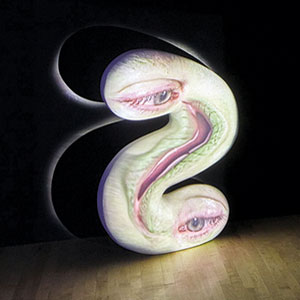Arts
'Almost Human' at SJMA
 UNCANNY: Tony Oursler's cheerfully demented 'Slip' on display at the SJMA's group exhibition, 'Almost Human.'
UNCANNY: Tony Oursler's cheerfully demented 'Slip' on display at the SJMA's group exhibition, 'Almost Human.'
The electronic sculptor and LED artist Jim Campbell can dazzle an exhibition gallery with pulsing, gleaming lights. But in the San Jose Museum of Art's survey of contemporary digital art, "Almost Human," he's represented by two pieces that are, if not unusually, then more transparently personal.
Photograph of My Mother and Portrait of My Father hang next to each other on the wall, the way that pictures do in the hallway of a family home. Each sculpture is like a smaller, more intimate version of one of his typical installations. They're both animated in different ways. But with these pieces, you approach the subtleties of the work rather than letting the work surround you or take you in.
Campbell places a photograph of his mother and another of his father in separate glass and plastic frames. The images appear clearly and then repeatedly disappear in a manufactured fog. This ongoing cycle mimics the way we recall our loved ones when we're separated from them. That idea is reinforced by the artist's physical connection to his family. Campbell recorded his heartbeat and the rhythm of his breathing to correspond with the temporary fog that returns to blur the images in their respective frames. His parents circle around in his memory, coming and going, but his breath and his bloodstream stay connected to them forever.
Tony Oursler's work is born in a neighboring mad scientist's laboratory where robots and humans collide. He takes a radically different path to achieve a hybrid form that borrows elements from both species. You walk into a dark room to encounter his cheerfully demented Slip. His fiberglass sculpture—the size of a tall, chubby child—is cast in the shape of a capital "S" in reverse. He casts one magnified eye into the upper and lower curves of the letter.
They look like a separated pair but could be the duplicated eye of a cyclops, blotchy red around the edges, blinking and wet. Oursler targets their sideways gaze directly at you but they look out and past you. These unseeing eyes are malfunctioning. They aren't taking in any information. Between them, an enlarged mouth in the middle utters sibilant, unintelligible phrases. You can walk through the projection and block out the distorted face with your body, but the disembodied, telltale voice persists. Here are parts of the human anatomy assembled to invert their function and purpose. This uncomposed face can only convey nonsense.
In addition to the occasional android figurines (shout out to Alan Rath), three artists simulate a digital version of nature. Last year, Pace Gallery exhibited teamLab's "Continuous Life and Death at the Now of Eternity," which featured several video screens of vivid, floating flowers. In comparison, Petra Cortright's 6_v211132013 is a digital still life. Nothing moves in her Photoshop "painting," but because her image lives inside an HDTV screen, you keep expecting one of the floral shapes to drift, wilt or change colors. The lovely, pale petals of Andrea Ackerman's Rose Breathing do flutter open and wave, but her moving image isn't ideally placed in the exhibit. It's the first thing you see from the lobby but should be around the corner, sharing a darkened corner with Slip.
Jennifer Steinkamp's Fly to Mars (no. 1) is a miraculous, gymnastic tree whose undulations stay in the brain after you walk away from it. Nearly lifesize, the tree of light is projected onto a wall. The branches sway up and down as if the tree were enjoying an afternoon gambol across a trampoline, its sedentary roots turned into agile toes, feet and legs. As the movement continues on a loop, the branches also cycle through the seasons, from bare winter to blossoms in spring. To create this effect, Steinkamp "rewrites 3D animation software code to create hyperreal animations." Nature recapitulated like this suggests the beauty of what it's imitating, but it also conveys the depressing quality of a specimen in a terrarium. Magritte got it right when he wrote, "Ceci n'est pas une pipe." at the bottom of his painting, The Treachery of Images. These aren't real flowers or trees, but I bet the robots in the room love the way they shimmer at night when the museum is lonely, cold and empty.
Almost Human
Thru Aug 9, 2020, $10
San Jose Museum of Art
sjmusart.org


